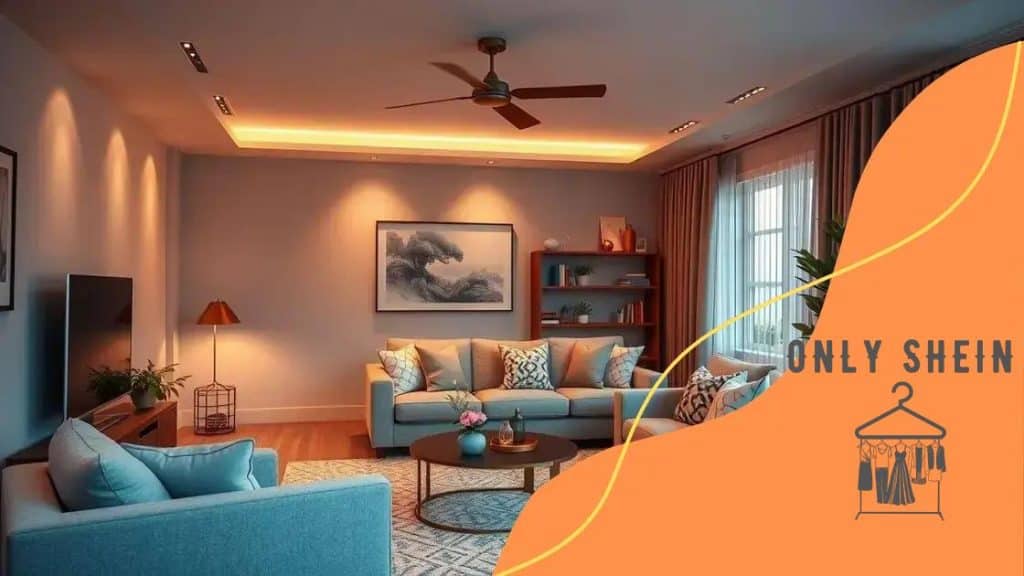Modern Shein home lighting ideas for a cozy vibe

Advertisements
Incorporating ambient lighting involves using fixtures that provide uniform illumination while enhancing the atmosphere of a space through a combination of warm color temperatures and strategic layering.
If you’re on the hunt for modern Shein home lighting ideas, you’re in for a treat. Imagine transforming your space into a cozy haven with just the right lighting. This guide explores creative solutions that can elevate your home’s ambiance.
Advertisements
Exploring various Shein lighting styles
When it comes to Shein lighting styles, there’s a unique blend of creativity and functionality. Exploring these styles can help you choose the perfect ambiance for each room in your home. Modern designs pair with practicality to enhance both aesthetics and usability.
Types of Shein Lighting Styles
Shein offers a variety of lighting options that cater to different tastes and preferences. From sleek modern fixtures to vintage-inspired designs, their range allows for endless possibilities in home decoration.
- Chandeliers: These elegant pieces serve as stunning focal points in dining rooms and entryways.
- Table Lamps: Perfect for side tables, table lamps add warmth and create a cozy feel in any room.
- Wall Sconces: Ideal for hallways or to highlight artwork, wall sconces can enhance your home’s charm.
- Ceiling Lights: A wide selection of flush mounts and pendant lights provide both style and illumination.
Mix and match these lighting styles to find the right combination that reflects your personal vibe. Incorporating various fixtures allows you to create layers of light, enhancing the overall mood of your spaces.
Advertisements
Choosing the Right Lighting for Your Home
While selecting Shein lighting styles, consider how each piece fits into your existing decor. For a modern look, choose pendant lights with clean lines and metallic finishes. If your decor leans more towards a rustic feel, consider fixtures with wood elements and warm tones.
Additionally, think about the function each light serves. Ambient lighting creates a soft glow, while task lighting focuses on areas where you need more illumination, like reading nooks or workspaces. Balancing these aspects can significantly improve your home’s functionality and aesthetics.
How to choose the right lighting for each room
Choosing the right lighting for each room can dramatically enhance your living space. Proper lighting not only sets the mood but also improves functionality. Understanding how different lights work in various areas of your home can guide your selections.
Living Room Lighting
The living room is often the heart of the home, where families gather. For this space, consider using a mix of ambient and task lighting. A chandelier or a large pendant light can serve as the main source, while floor lamps and table lamps provide additional light for reading or relaxing.
- Soft white bulbs: Create a warm and inviting atmosphere.
- Dimmer switches: Allow for adjusting the brightness based on activities.
- Accent lights: Highlight artwork or architectural features.
Layering lights helps create depth and warmth, making the living area feel inviting.
Kitchen Lighting
In the kitchen, functionality is key. Here, lighting needs to support food preparation while also providing a welcoming environment. Bright task lighting is essential over countertops and cooking areas. A combination of recessed lights and pendant lights over the island can effectively illuminate the space.
Consider under-cabinet lighting to enhance visibility for cooking tasks while adding elegance. Bright LED lights can ensure safety and highlight beautiful backsplash tiles.
Bedroom Lighting
The bedroom should feel relaxing and serene. Use softer lighting options to create a tranquil atmosphere. A combination of ceiling fixtures, nightstand lamps, and wall sconces can provide versatile options for your lighting needs.
Incorporating dimmable lights allows you to adjust brightness for different activities. During bedtime, softer light aids in relaxation, making it easier to unwind after a long day.
Bathroom Lighting
When choosing bathroom lighting, focus on both function and aesthetics. Bright lighting is crucial for tasks like shaving or applying makeup. Overhead lights paired with vanity lights can help ensure you have enough illumination.
Consider using canister lights or sconces to eliminate shadows in the mirror. Additionally, make sure to choose fixtures that can withstand humidity.
DIY tips for installing Shein lights at home

Installing Shein lights at home can be an exciting DIY project. It allows you to personalize your space while enhancing its beauty. The right lights can transform any room into a comfortable and stylish area.
Gather Your Tools
Before starting, assemble the necessary tools and materials. Commonly needed items include a screwdriver, measuring tape, wire cutters, and, most importantly, your chosen Shein lighting fixtures. Having everything on hand makes the installation process smoother.
- Tools: Screwdriver, wire cutters, measuring tape.
- Materials: Light fixtures, screws, electrical tape.
- Safety gear: Gloves and safety glasses.
Wearing safety gear ensures that you remain protected throughout the installation.
Plan Your Layout
Next, think about where you want to install the lights. Planning your layout helps in visualizing the effects and ensuring that the lighting meets your needs. Consider the following:
- Functionality: Decide which areas need brighter light.
- Aesthetics: Choose locations that will best showcase the fixtures.
- Height: Hang lights at appropriate heights for a balanced look.
By planning carefully, you can create an inviting atmosphere that highlights your home’s beauty.
Follow Safety Protocols
Safety is crucial during installation. Always turn off the power to the area where you will be working. Double-check that the circuit breaker is off to avoid any accidents. Use insulated tools, and follow all instructions provided with your lights. If you are unsure, consider consulting a professional electrician.
Once everything is in place, test the lights before securing them fully to ensure they work correctly. This step allows for adjustments without needing to disassemble installed pieces.
Final Touches
After installation, take a moment to admire your work. Add finishing touches, like adjusting the brightness or changing the light bulbs for a different effect. The right bulbs can alter the ambiance significantly; warm white bulbs create a cozy feel, while bright white bulbs can be energizing.
Balancing functionality and aesthetics in home lighting
Balancing functionality and aesthetics in home lighting is essential for creating comfortable and stylish spaces. Good lighting does more than brighten a room; it enhances your home’s decor and contributes to the atmosphere.
Understanding Lighting Types
To effectively balance these aspects, it is crucial to understand the different types of lighting available. There are three primary categories: ambient, task, and accent lighting. Each plays a unique role in enhancing your space.
- Ambient lighting: This is the overall illumination in a room, providing a comfortable level of brightness.
- Task lighting: Focused light for specific activities, such as reading or cooking, ensuring safety and ease of use.
- Accent lighting: Highlights artwork or architectural features, adding depth and interest to your decor.
These three types work together to create a well-lit environment that is both functional and visually appealing.
Choosing Fixtures Wisely
When selecting fixtures, consider both their functional purpose and how they blend into your home’s style. For example, a stylish pendant light can serve as both a task light over a kitchen island and an aesthetic focal point. Similarly, chic wall sconces can provide functional lighting while enhancing the room’s character.
Consider while choosing how different finishes and materials can complement your existing decor while serving practical needs. Mixing metals and textures can add visual interest without compromising on utility.
Creating Layers of Light
Creating layers of light in a room further enhances both functionality and aesthetics. By combining different types of lighting, you can achieve a more dynamic space. For instance, placing lamps in the corners adds immediate warmth, while a dimmable ceiling fixture gives you control over the overall brightness.
Using these layers allows you to adjust the mood depending on the time of day and activities. Incorporating dimmers and smart lighting solutions can also provide flexibility, letting you change the atmosphere instantly.
Focusing on Color Temperature
The color temperature of your lights affects both functionality and aesthetics as well. Warmer lights (between 2700K-3000K) create a cozy and inviting environment, making them perfect for living rooms and bedrooms. On the other hand, cooler lights (around 4000K) can energize a space, making them suitable for kitchens and workspaces.
Choosing the right color temperature can enhance the mood of the room while also ensuring that the space remains functional for its intended use.
Incorporating ambient lighting for a welcoming atmosphere
Incorporating ambient lighting is key to creating a welcoming atmosphere in any home. Ambient lighting provides a uniform light level that fills a room, making it bright enough for daily tasks while also setting a cozy mood.
Choosing the Right Fixtures
Selecting the right fixtures is crucial for effective ambient lighting. Options like flush mount ceiling lights and soft-glowing pendant lights can enhance the overall feel of your space. These fixtures distribute light evenly, reducing harsh shadows and creating a comfortable environment.
- Flush Mount Lights: Ideal for lower ceilings, offering a clean look.
- Pendant Lights: Perfect for dining areas, adding style while providing broad illumination.
- Recessed Lighting: For a sleek and modern appearance, blending seamlessly into the ceiling.
Consider the size and style of your room when selecting fixtures to ensure they complement your decor.
Using Color Temperature Wisely
The color temperature of your bulbs plays a significant role in setting the atmosphere. Warmer lights (around 2700K to 3000K) create a snug and inviting space, perfect for living rooms and bedrooms. In contrast, cool lights (above 4000K) can give off a more energetic vibe, suitable for workspaces or kitchens.
By thoughtfully selecting color temperatures, you enhance the mood of the space, making it feel either cozy or invigorating based on your needs.
Layering Your Lighting
A well-designed ambient lighting scheme often includes layers. Combining floor lamps, table lamps, and wall sconces can help achieve a rich, dynamic look. This layered approach allows different light sources to work together, creating depth and warmth in your room.
In addition to ambient lighting, using various light sources adds texture and warmth, ensuring that spaces feel balanced and inviting.
Incorporating Natural Light
Incorporating natural light is another effective way to enhance ambient lighting. Open curtains and blinds during the day to let sunlight illuminate your space. Mirrors can also help reflect natural light, making rooms feel brighter and more expansive.
A space filled with natural light combined with soft artificial lighting creates a harmonious environment, complementing both aesthetics and comfort.
FAQ – Frequently Asked Questions about Incorporating Ambient Lighting
What is ambient lighting?
Ambient lighting is the overall illumination that fills a room, providing a comfortable level of brightness for daily activities.
How do I choose the right fixtures for ambient lighting?
Select fixtures like flush mount lights and pendant lights that distribute light evenly and suit your room’s style.
Why is color temperature important?
Color temperature affects the mood of a room; warmer lights create a cozy atmosphere, while cooler lights energize the space.
Can I use dimmers for ambient lighting?
Yes, installing dimmers allows you to adjust the intensity of light, making it easier to create the desired ambiance based on the time of day.